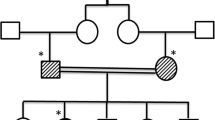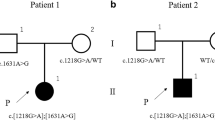Abstract
Purpose
Autoimmune polyglandular syndrome Type 1 (APS-1) is a rare autosomal recessive disorder caused by defects in the autoimmune regulator (AIRE) gene. Patients are generally diagnosed at ages between five and fifteen years when they exhibit three or more manifestations, most typically mucocutaneous candidiasis, autoimmune Addison’s disease, and hypoparathyroidism. Our study aims to report the first case of a Chinese APS-1 patient, presented with LCA as the initial and essential clinical feature of this rare syndrome.
Methods
Detailed medical and family history were recorded for the patient. Also, the comprehensive ophthalmological examinations were conducted. Whole exome sequencing (WES) was applied to screen pathogenic variants. Sanger sequencing validation and segregation analysis were further performed for confirmation.
Results
A 3-year-old boy with severely impaired vision and initially referred as LCA. However, with a detailed history review, oral candidiasis, dental enamel hypoplasia, and nail candida infection were revealed. Moreover, genetic analysis revealed the homozygous c.769C>T (p.R257X) in AIRE gene (NM_000383.3) as the causative variant.
Conclusion
We presented one case diagnosed with APS-1 based on clinical characteristics and genetic analysis. Our study demonstrated that LCA could serve as a warning sign for APS-1 and a potential trigger of early screening, which might prevent life-threatening complications.


Similar content being viewed by others
Data availability
The data used in this study are available from the corresponding author upon reasonable request.
References
Fierabracci A (2011) Recent insights into the role and molecular mechanisms of the autoimmune regulator (AIRE) gene in autoimmunity. Autoimmun Rev 10(3):137–143
Guo CJ, Leung PSC, Zhang W, Ma X, Gershwin ME (2018) The immunobiology and clinical features of type 1 autoimmune polyglandular syndrome (APS-1). Autoimmun Rev 17(1):78–85
Orlova EM, Sozaeva LS, Kareva MA, Oftedal BE, Wolff ASB, Breivik L et al (2017) Expanding the phenotypic and genotypic landscape of autoimmune polyendocrine syndrome type 1. J Clin Endocrinol Metab 102(9):3546–3556
Sharifinejad N, Zaki-Dizaji M, Tebyanian S, Zainaldain H, Jamee M, Rizvi FS et al (2021) Clinical, immunological, and genetic features in 938 patients with autoimmune polyendocrinopathy candidiasis ectodermal dystrophy (APECED): a systematic review. Expert Rev Clin Immunol 17(8):807–817
Ahonen P, Myllärniemi S, Sipilä I, Perheentupa J (1990) Clinical variation of autoimmune polyendocrinopathy-candidiasis-ectodermal dystrophy (APECED) in a series of 68 patients. N Engl J Med 322(26):1829–1836
Kisand K, Peterson P (2011) Autoimmune polyendocrinopathy candidiasis ectodermal dystrophy: known and novel aspects of the syndrome. Ann N Y Acad Sci 1246:77–91
Sato K, Nakajima K, Imamura H, Deguchi T, Horinouchi S, Yamazaki K et al (2002) A novel missense mutation of AIRE gene in a patient with autoimmune polyendocrinopathy, candidiasis and ectodermal dystrophy (APECED), accompanied with progressive muscular atrophy: case report and review of the literature in Japan. Endocr J 49(6):625–633
Yan Z, Gang X, Xie X, Gao Y, Li Z, Wang G (2020) A case report and literature review: Identification of a novel AIRE gene mutation associated with autoimmune polyendocrine syndrome type 1 in east Asians. Medicine (Baltimore) 99(18):e20000
Robson AG, Frishman LJ, Grigg J, Hamilton R, Jeffrey BG, Kondo M et al (2022) ISCEV Standard for full-field clinical electroretinography (2022 update). Doc Ophthalmol 144(3):165–177
Li J, Shi L, Zhang K, Zhang Y, Hu S, Zhao T et al (2018) VarCards: an integrated genetic and clinical database for coding variants in the human genome. Nucleic Acids Res 46(D1):D1039–D1048
Schwarz JM, Cooper DN, Schuelke M, Seelow D (2014) MutationTaster2: mutation prediction for the deep-sequencing age. Nat Methods 11(4):361–362
Kircher M, Witten DM, Jain P, O’Roak BJ, Cooper GM, Shendure J (2014) A general framework for estimating the relative pathogenicity of human genetic variants. Nat Genet 46(3):310–315
Quang D, Chen Y, Xie X (2015) DANN: a deep learning approach for annotating the pathogenicity of genetic variants. Bioinformatics 31(5):761–763
Shihab HA, Rogers MF, Gough J, Mort M, Cooper DN, Day IN et al (2015) An integrative approach to predicting the functional effects of non-coding and coding sequence variation. Bioinformatics 31(10):1536–1543
Davydov EV, Goode DL, Sirota M, Cooper GM, Sidow A, Batzoglou S (2010) Identifying a high fraction of the human genome to be under selective constraint using GERP++. PLoS Comput Biol 6(12):e1001025
Bourgault S, Baril C, Vincent A, Héon E, Ali A, MacDonald I et al (2015) Retinal degeneration in autoimmune polyglandular syndrome type 1: a case series. Br J Ophthalmol 99(11):1536–1542
Perheentupa J (2006) Autoimmune polyendocrinopathy-candidiasis-ectodermal dystrophy. J Clin Endocrinol Metab 91(8):2843–2850
Richards S, Aziz N, Bale S, Bick D, Das S, Gastier-Foster J et al (2015) Standards and guidelines for the interpretation of sequence variants: a joint consensus recommendation of the American college of medical genetics and genomics and the association for molecular pathology. Genet Med 17(5):405–424
Kashem SW, Binstadt BA (2017) Pathogenic and protective autoantibodies in autoimmune polyendocrinopathy-candidiasis-ectodermal dystrophy (APECED). Antibodies (Basel) 6(1):1
Husebye ES, Perheentupa J, Rautemaa R, Kämpe O (2009) Clinical manifestations and management of patients with autoimmune polyendocrine syndrome type I. J Intern Med 265(5):514–529
Couturier A, Brézin AP (2016) Ocular manifestations of autoimmune polyendocrinopathy syndrome type 1. Curr Opin Ophthalmol 27(6):505–513
Wang Y-B, Wang O, Nie M, Jiang Y, Li M, Xia W-B et al (2021) Characterization of the clinical and genetic spectrum of autoimmune polyendocrine syndrome type 1 in Chinese case series. Orphanet J Rare Dis 16(1):296
Aaltonen J, Björses P, Perheentupa J, Horelli-Kuitunen N, Palotie A, Peltonen L, Lee YS, Francis F, Henning S, Thiel C, Leharach H (1997) An autoimmune disease, APECED, caused by mutations in a novel gene featuring two PHD-type zinc-finger domains. Nat Genet 17(4):399–403
Nagamine K, Peterson P, Scott HS, Kudoh J, Minoshima S, Heino M et al (1997) Positional cloning of the APECED gene. Nat Genet 17(4):393–398
Stenson PD, Ball EV, Mort M, Phillips AD, Shiel JA, Thomas NS et al (2003) Human gene mutation database (HGMD): 2003 update. Hum Mutat 21(6):577–581
Perniola R, Musco G (2014) The biophysical and biochemical properties of the autoimmune regulator (AIRE) protein. Biochim Biophys Acta 1842(2):326–337
Varadi M, Anyango S, Deshpande M, Nair S, Natassia C, Yordanova G et al (2022) AlphaFold Protein Structure Database: massively expanding the structural coverage of protein-sequence space with high-accuracy models. Nucleic Acids Res 50(D1):D439–D444
Borchers J, Pukkala E, Mäkitie O, Laakso S (2020) Patients with APECED Have Increased early mortality due to endocrine causes, malignancies and infections. J Clin Endocrinol Metab 105(6):e2207–e2213
O’Gorman CS, Shulman R, Lara-Corrales I, Pope E, Marcon M, Grasemann H et al (2013) A child with autoimmune polyendocrinopathy candidiasis and ectodermal dysplasia treated with immunosuppression: a case report. J Med Case Rep 7:44
Padeh S, Theodor R, Jonas A, Passwell JH (1997) Severe malabsorption in autoimmune polyendocrinopathy-candidosis-ectodermal dystrophy syndrome successfully treated with immunosuppression. Arch Dis Child 76(6):532–534
Besnard M, Sérazin C, Ossart J, Moreau A, Vimond N, Flippe L et al (2022) Anti-CD45RC antibody immunotherapy prevents and treats experimental autoimmune polyendocrinopathy-candidiasis-ectodermal dystrophy syndrome. J Clin Invest. https://doi.org/10.1172/JCI156507
Acknowledgements
We thank the patient and his family members for participating in the study.
Funding
This work was supported by CAMS Innovations Fund for Medical Sciences (CIFMS 2021-I2M-1-003 and CIFMS 2022-I2M-C&T-B-024) and the National Natural Science Foundation of China 81873687.
Author information
Authors and Affiliations
Contributions
XW wrote the main manuscript. RS designed and revised the paper. XW, RS, TZ, and LW examined the patients. XW and RS performed the genetic analysis. All authors reviewed the results and approved the manuscript.
Corresponding author
Ethics declarations
Conflict of interest
The authors declare that they have no conflict of interest.
Statement of human rights
This study was complied with the Guidance on Sample Collection of Human Genetic Diseases by the Ministry of Public Health of China and the tenets of the Declaration of Helsinki. The Institutional Review Board of PUMCH (No. JS-2059) approved the study.
Statement on the welfare of animals
Not applicable.
Informed consent
Informed consent for participation and publication of this study was obtained from the guardians of the patient.
Additional information
Publisher’s Note
Springer Nature remains neutral with regard to jurisdictional claims in published maps and institutional affiliations.
Supplementary Information
Below is the link to the electronic supplementary material.
Rights and permissions
Springer Nature or its licensor (e.g. a society or other partner) holds exclusive rights to this article under a publishing agreement with the author(s) or other rightsholder(s); author self-archiving of the accepted manuscript version of this article is solely governed by the terms of such publishing agreement and applicable law.
About this article
Cite this article
Wei, X., Zhu, T., Wang, L. et al. Leber congenital amaurosis as the initial and essential manifestation in a Chinese patient with autoimmune polyglandular syndrome Type 1. Doc Ophthalmol 147, 225–232 (2023). https://doi.org/10.1007/s10633-023-09953-8
Received:
Accepted:
Published:
Issue Date:
DOI: https://doi.org/10.1007/s10633-023-09953-8




